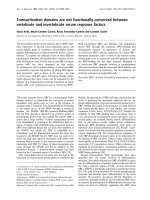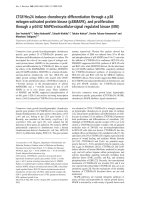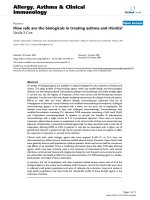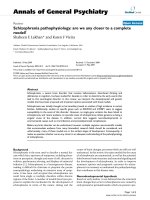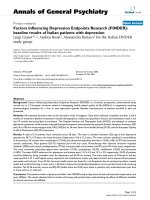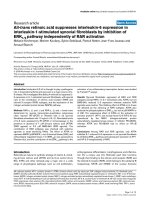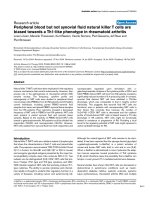Báo cáo y học: "All motifs are not created equal: structural properties of transcription factor - dna interactions and the inference of sequence specificity" doc
Bạn đang xem bản rút gọn của tài liệu. Xem và tải ngay bản đầy đủ của tài liệu tại đây (576.79 KB, 22 trang )
Genome Biology 2005, 6:P7
Deposited research article
All motifs are not created equal: structural properties of
transcription factor - dna interactions and the inference of
sequence specificity
Michael B Eisen
Addresses: Center for Integrative Genomics, Division of Genetics and Development, Department of Molecular and Cell Biology, University of
California Berkeley, Berkeley, USA. Department of Genome Sciences, Genomics Division, Ernest Orlando, Lawrence Berkeley National Lab,
Berkeley, USA. E-mail:
comment
reviews
reports
deposited research
interactions
information
refereed research
.deposited research
AS A SERVICE TO THE RESEARCH COMMUNITY, GENOME BIOLOGY PROVIDES A 'PREPRINT' DEPOSITORY
TO WHICH ANY ORIGINAL RESEARCH CAN BE SUBMITTED AND WHICH ALL INDIVIDUALS CAN ACCESS
FREE OF CHARGE. ANY ARTICLE CAN BE SUBMITTED BY AUTHORS, WHO HAVE SOLE RESPONSIBILITY FOR
THE ARTICLE'S CONTENT. THE ONLY SCREENING IS TO ENSURE RELEVANCE OF THE PREPRINT TO
GENOME BIOLOGY'S SCOPE AND TO AVOID ABUSIVE, LIBELLOUS OR INDECENT ARTICLES. ARTICLES IN THIS SECTION OF
THE JOURNAL HAVE NOT BEEN PEER-REVIEWED. EACH PREPRINT HAS A PERMANENT URL, BY WHICH IT CAN BE CITED.
RESEARCH SUBMITTED TO THE PREPRINT DEPOSITORY MAY BE SIMULTANEOUSLY OR SUBSEQUENTLY SUBMITTED TO
GENOME BIOLOGY OR ANY OTHER PUBLICATION FOR PEER REVIEW; THE ONLY REQUIREMENT IS AN EXPLICIT CITATION
OF, AND LINK TO, THE PREPRINT IN ANY VERSION OF THE ARTICLE THAT IS EVENTUALLY PUBLISHED. IF POSSIBLE, GENOME
BIOLOGY WILL PROVIDE A RECIPROCAL LINK FROM THE PREPRINT TO THE PUBLISHED ARTICLE.
Posted: 31 March 2005
Genome Biology 2005, 6:P7
The electronic version of this article is the complete one and can be
found online at />© 2005 BioMed Central Ltd
Received: 30 March 2005
This is the first version of this article to be made available publicly.
This information has not been peer-reviewed. Responsibility for the findings rests solely with the author(s).
All Motifs are NOT Created Equal:
Structural Properties of Transcription Factor – DNA Interactions and
the Inference of Sequence Specificity
Michael B. Eisen
Affiliations:
Center for Integrative Genomics
Division of Genetics and Development
Department of Molecular and Cell Biology
University of California Berkeley
Berkeley, CA
Department of Genome Sciences
Genomics Division
Ernest Orlando Lawrence Berkeley National Lab
Berkeley, CA
Contact:
Michael B. Eisen
Mailstop 84-171
One Cyclotron Road
Berkeley, CA 94720
Email:
Tel: +1 (510) 486-5214
FAX: +1 (786) 549-0137
Abstract
The identification of transcription factor binding sites in genome sequences is an
important problem in contemporary sequence analysis, and a plethora of approaches to
the problem have been proposed, implemented and evaluated in recent years. Although
the biological and statistical models, descriptions of binding sites and computational
algorithms used vary considerably amongst these methods, most share a common
assumption – that all motifs are equally likely to be transcription factor binding sites.
Here we argue that this simplifying assumption is incorrect – that the specific nature of
transcription factor-DNA interactions imposes constraints on the types of motifs that are
likely to be transcription factor binding sites and on the relationships between motifs
recognized by members of structurally similar transcription factors. We propose that our
structural and biochemical understanding of the interactions between transcription factors
and DNA can be used to guide de novo motif detection methods, and, in a series of
related papers introduce several methods that incorporate this idea.
Introduction:
Of the myriad ways that cells control the abundance and activity of the proteins
encoded by their genomes, regulation of mRNA synthesis is perhaps the most general and
significant. Transcriptional regulation plays a central role in a multitude of critical
cellular processes and responses, and is a central force in the development and
differentiation of multicellular organisms. There has thus been considerable interest in
understanding how genome sequences specify when and where genes should be
transcribed, and the availability of a wide range of genome sequences has greatly
accelerated research to decipher the genomic regulatory code.
Although they are only part of the complex networks that regulate transcription,
sequence specific DNA binding proteins (transcription factors) provide a crucial link
between DNA sequence and the cellular machinery that controls and carries out mRNA
synthesis. Transcription factors regulate gene expression by binding to sequences
flanking a gene (cis-sequences), interacting with each other and with other proteins (e.g.
cofactors, chromatin-remodeling enzymes, and general transcription factors) to modulate
the rate of transcription initiation at the appropriate promoter. To a large extent, the
specific temporal, positional and conditional pattern of expression of each gene is a
function (albeit a very complicated one) of the arrangement of transcription factor
binding sites in its cis-DNA.
Thus, in analyzing the transcription regulatory content of a genome, it is of
paramount importance to know the binding specificities of all the organism’s
transcription factors. Although methods exist to experimentally determine the in vitro [1,
2] and in vivo [3-5] binding specificities of transcription factors, it is not yet feasible to
routinely apply these methods to the hundreds or thousands of transcription factors
encoded by most organisms’ genomes.
There has, therefore, been considerable focus on methods to deduce the binding
specificities of transcription factors in the absence of direct experimental data. In recent
years, two largely independent approaches to this problem have emerged. In one
approach, structural and biochemical rules are used to predict the binding specificity of a
given transcription factor given its amino acid sequence (reviewed in [6]). In a second
approach, statistical models are used to identify from genome sequences and other
information those sequences – or more precisely models of related families of sequences-
that are likely to be binding sites for some biologically active transcription factor
(reviewed in [7]). Surprisingly, although both of these approaches show considerable
promise, there have been few efforts to combine their insights into a unified approach to
the de novo detection and prediction of transcription factor binding sites. Here, we briefly
review these two different approaches, point out the ways in which they can usefully be
combined, and propose an approach to transcription factor binding site detection that
incorporates aspects of both approaches. A series of related papers describe specific
implementations and evaluations of this approach.
Modeling and Inference of Transcription Factor Binding Specificities
Following early structural work on protein-DNA complexes, there was
considerable optimism that a protein recognition code would be discovered that would
allow for the binding specificity of a factor to be directly deduced from its amino acid
sequence [8]. However, as more and more structures were determined, it became clear
that such a deterministic code does not exist [9], with recent studies highlighting how the
detailed complexity and subtle variation of protein-DNA interactions makes such a code
impossible to deduce [10].
In recent years, the idea of a deterministic code has been replaced by that of a
“probabilistic code”, in which the amino acid sequence of a transcription factor – in
particular the identity of bases known to interact with DNA in related proteins – is used
to assess the likelihood that a given sequence will be bound by the factor or to design
factors likely to bind to a given target sequence [6, 11-17].
An entirely different approach has emerged with the increased availability of
genome sequence data. In particular, numerous methods have been developed and
applied to infer models of transcription factor binding sites directly from sequences, often
in combination with other types of information. For example, a large class of approaches
seeks models of transcription factor binding sites (usually in the form of position-weight
matrixes [18, 19]) that are enriched in sets of sequences that, based on experimental data,
are thought to contain common transcription factor binding sites. Enriched sequences are
identified in various ways, the most common based on maximum likelihood estimations
of finite mixture models as implemented in MEME [20] or the Gibbs sampler [21]. Many
alternate approaches have been introduced, including word counting methods [22-24],
probabilistic segmentation or dictionary based approaches [25], and direct modeling of
the relationship between sequences and expression data [26, 27].
Although the biological and statistical models, descriptions of binding sites and
computational algorithms used vary considerably amongst these methods, they all share
the assumption that all motifs are created equal; that any and all motifs have an equal a
priori probability of being a transcription factor binding site. Our central argument
here is that this assumption is incorrect – that the biophysical and biochemical
nature of transcription factor-DNA (TF-DNA) interactions imposes constraints on
the types of motifs that are likely to be transcription factor binding sites, and that
our structural and biochemical understanding of the interactions between
transcription factors and DNA can be used to guide de novo motif detection
methods.
Constraints on Sequence Specificities:
Transcription factors rarely bind exclusively to a single nucleotide sequence.
Rather, they usually recognize a family of sequences that share some highly conserved
bases as well as some more flexible positions (see Figure 1). These families of sequences
are generally described either as consensus sequences (Figure 1B) that specify which
base(s) are acceptable at each position or as position-weight matrixes (PWMs; Figure 1C)
that describe the probability of observing each base at each position within bound
sequences. Because consensus sequences are a special case of PWMs, and because there
is solid theory relating PWMs to binding affinities [28, 29], we will limit this discussion
to PWMs.
The matrix values of a PWM specify the relative preference of the transcription
factor for specific bases at each position. Binding sites (and PWMs) can also be
characterized by the overall tolerance of the factor for substitution at each position within
the site. A common measure of this substitution tolerance is Shannon information ([30];
Figure 1D). Information (formally
∑
=
−=
},,,{
2
log2
TGCAB
BB
ffI
where
B
f
is the frequency of
base B [31]) is inversely proportional to substitution tolerance, and can be thought of as a
direct measure of the selectivity of the transcription factor at each position, with higher
information representing greater selectivity. Positions where only one base is ever
observed have little tolerance for base substitutions and therefore contain maximal
information (2.0), while all bases are observed at equal frequency have minimal
information (0.0).
Although information is a function only of observed base frequencies in
sequences bound by the factor, it is natural to think of information as a measure of the
importance of each base in productive transcription factor-DNA interactions as a site’s
tolerance for substitution should reflect the nature and extent of its contacts with the
transcription factor. An important recent paper [32] provides support for this relationship.
These authors analyzed five bacterial DNA binding proteins, whose structures bound to
DNA had been determined by x-ray crystallography, and computed the number of
contacts between each base in the bound DNA and the protein. For each factor they
assembled collections of sequences known from experimental data to be bound by the
protein, computed PWMs from these sequences, and showed that there is a strong
correlation between the number of contacts at a position in the bound sequence and the
information content of the corresponding position of the PWM. Bases that are more
extensively contacted by the protein are more conserved. We have observed a similar
relationship for several yeast transcription factors.
Although this observation that there is relationship between the structural
footprint of a protein on DNA and the information profile of the PWM that describes
sequences bound by this protein is, in some ways, fairly obvious and has been indirectly
described previously [33],
it is surprising that this fundamental characteristic of
protein-DNA interactions has not been incorporated into de novo motif detection
algorithms
. Here, we propose several ways in which this could be accomplished, and in
a related set of papers offer specific implementations of these ideas.
Clustering of information within PWMs
.
Transcription factors rarely contact a single base without interacting with adjacent
bases. For example, many types of transcription factors insert an alpha-helix into the
major groove of DNA and make base-specific contacts with 4 or 5 adjacent nucleotides,
with the most contacts being made to the central 2 or 3 nucleotides [34]. It follows that
the position of high information (and thus also low information) positions should be
clustered within PWMs.
Such clustering is observed in transcription factor PWMs based on experimental
data. Figure 2 shows that, in PWMs from the transcription factor database TRANSFAC
[35], there is a strong correlation between the information at adjacent position (the
information content of all pairs of adjacent positions shows a Pearson correlation of 0.57,
as compared to an average Pearson correlation of 0.14 for 100 trials where the positions
within each matrix were randomly permuted).
As will be discussed below, this common feature of PWMs that represent bona
fide transcription factor binding sites can be readily incorporated into motif detection
algorithms and used to improve the specificity and sensitivity.
Shared information profiles for structurally related transcription factors.
An important corollary of the observation that there is a relationship between the
structural footprint of a transcription factor bound to DNA and the information profile of
its PWM, is that if we knew (or could predict) the footprint of a transcription factor on
DNA then we would expect the information profile of the PWM describing sequences
bound by this factor to match this footprint.
Of course, it is not practical to experimentally determine the structural footprint of
every factor in which we are interested. However, it should often be possible to infer the
structural footprint – or equivalently the expected information content of the PWM –
from those of structurally related transcription factors. An examination of transcription
factor-DNA complexes for factors within the same broad structural class, suggests that
the structural footprint of TFs on DNA is often reasonably well conserved, even when the
amino acid sequence and binding specificity of the factor are not. Therefore, and we can
hypothesize that the PWMs for homologous transcription factors should have similar
information profiles. To the extent that this is true (a detailed examination of the PWMs
in TRANSFAC loosely supports this hypothesis, although the quantity and quality of the
data were insufficient to demonstrate it conclusively), this property could have a
significant impact on methods to recognize transcription factor binding sites and on our
ability to match identified motifs with specific transcription factors.
For example, PWMs describing the binding sites of homeodomain proteins (of the
helix-turn-helix family of transcription factors) generally have a core of 4 highly
conserved bases flanked on either side by 1 or 2 more partially conserved bases. This is
consistent with the structures of homeodomain proteins complexed to DNA, in which an
α
-helix positioned in the DNA major groove makes extensive contacts with 4 or 5 bases
and lesser contacts with a few bases flanking this core on either side. When attempting to
construct a PWM describing sites that might be bound by an otherwise uncharacterized
homeodomain protein, it would make sense to begin by looking for motifs with similar
information profiles to other homeodomain binding sites.
A more concrete example of where such a strategy could be used is the recent
determination of sequences bound in vivo by 107 different transcriptional regulators
(most of which are DNA binding proteins) of the yeast Saccharomyces cerevisiae [36].
The authors of this work attempted to use their data to discover or refine PWMs
describing each factor’s binding specificity by running the program MEME on each set
of bound sequences. In some cases, this approach was successful. However, in a
surprising number of cases the results were inaccurate or uninformative.
Ninety of these factors are members of well-characterized families of
transcription factors or contain well-characterized DNA binding motifs [37]. We can use
the expectation that transcription factors sharing a common DNA binding domain will
have corresponding PWMs with similar information profiles to make predictions about
the information profiles of the PWMs for most of these ninety factors. As is discussed in
the four related papers, this expectation can be built into motif detection algorithms and
used to search not simply for enriched motifs (as is done by MEME), but for enriched
motifs that have the expected information profile. Our results in applying these methods
to the data of [36] will be detailed in a forthcoming publication.
Use of Common Principles in Motif Detection Algorithms
Both the general and specific properties of transcription factor PWMs discussed
above can be readily incorporated into standard motif detection strategies. From a
statistical/algorithmic point of view, expectations about the information profile of PWMs
can be thought of in two complementary ways. First, they can be thought of as prior
knowledge, and implemented as a statistical prior on the space of motifs representing the
likelihood that a given motif is a transcription factor binding site or a binding site for a
specific family of transcription factor. Most current motif detection algorithms (e.g.
MEME, Gibbs sampler) assume a uniform prior - that all PWMs are equally likely to
describe a transcription factor binding site regardless of how information is distributed
within the PWM. Alternatively, these expectations can be thought of as a constraint on
the motifs that are identified by the motif detection algorithm. For example, in searching
for homeodomain binding sites we could search only for motifs with an appropriate
information profile.
We note that MEME and several other motif detection algorithms already
implement one type of structural constraint imposed by specific structural characteristics
of a class of transcription factors, namely those that bind DNA as homodimers. In most
cases, these factors recognize motifs with an internal 2-fold axis of symmetry (e.g.
CGTACG). If it is known that a factor is – or could be – a homodimer, it makes sense to
only consider 2-fold symmetric motifs as possible examples of binding sites. MEME, for
example, implements this “palindrome” constraint by averaging motifs across a 2-fold,
reverse complemented axis of symmetry following the M-step of the EM algorithm.
It is important to note that in no case do the constraints we are discussing place
any constraints on the sequence specificity at any position – the constraints only exist at
the level of the information profile of the motif. Thus, these methods can be thought of as
complementing methods that use amino acid preference rules to predict the base
specificity of a factor [15, 17, 29, 38].
We have evaluated several of these methods, pursuing a number of
complementary approaches described in four separate papers. Two of these methods [39,
40] use prior distributions to describe a dependence structure between the positions of the
PWM, and two others [41, 42] use constraints on the entropy structure of the PWMs.
The approach described in [42] employs a motif model that allows specific
ordering of the information of the individual motif positions (e.g. the information in
position i is greater than that of position j, or, more generally, that the information in the
motif has one or two peaks) and uses the EM-algorithm to maximize the likelihood of the
sequence and model under this constraint. Under the simplifying assumption that at each
position j of a motif there is one (unknown) preferred residue with (unknown) probability
j
p > ¼ while the remaining nucleotides have a probability
3
1
j
p−
each, it becomes
straightforward to compute the maximum likelihood estimator of a PWM under order
restrictions on the information content of its columns and a global maximum can be
obtained easily.
[41]employ a general constraint model in which the information profile of a motif
is constrained to belong to a user-specified family of information profiles, e.g. motifs
with maximal information in a central base and linearly declining information for
positions flanking this central base. The method is fairly flexible in allowing for arbitrary
parametric families of information profiles. The maximum likelihood PWM fitting the
specified constraint is identified using the EM algorithm, where the M-step employs a
constrained nonlinear maximization method.
[39]implement the concept of strong, moderate and weak “conservedness”
(corresponding to high, intermediate and low information) at given positions of the PWM
through specific priors that do not constrain which specific nucleotides are conserved.
Positions in the motif are partitioned into one of the three regimes (strong, moderate, or
weak conservation), based on prior knowledge or assumptions about the information
profile sought. The likelihood of PWMs deviating from the specified prior are penalized
based on the extent of their deviation, with the strength of the penalty under user control.
The penalized likelihood is maximized with the EM algorithm in which the M-step is
closed form (and thus the optimization is more efficient) for most of the regime types.
[40]considers a more complex prior distribution on the motif PWM. The
multinomial probabilities at each position are drawn from a mixture of Dirichlet
distributions (each position of the PWM is indexed by a hidden class variable and the
prior distribution on the multinomial nucleotide probabilities are drawn according to this
class). To enforce the dependence structure among the positions of the motif, the hidden
class variables are drawn from a first order markov chain identified by a
K by
K
transition matrix (
K
is the number of components in the Dirichlet mixture) and
marginal distribution of the class variable at the first position. The number of prior
classes (the number of components in the Dirichlet mixture) are chosen by the user. The
corresponding parameters of the Dirichlet prior distributions, and the transition matrix for
the first order markov chain are supplied by the user, with parameters optimally obtained
from a set of training motifs.
Future Directions
Here, and in a series of related papers, we have discussed how structural
characteristics of transcription factor–DNA interactions constrain the families of
sequences bound by transcription factors, and how these constraints can be used in motif
detection. We believe these methods are the basis for a more expansive and productive
fields of structure based
de novo motif detection.
There are clearly many challenges for fully realizing this idea. In particular, there
is a need for far more high-quality data on the binding specificities of transcription
factors. In attempting to analyze available binding matrixes in TRANSFAC [35], we
were struck by how few examples there were of factors whose binding specificities were
reasonably comparable, owing largely to extreme heterogeneity in the methods used to
experimentally and computationally characterize these affinities. We believe that
continued progress in this field is dependent upon the consistent application of high-
throughput, high-accuracy measurements of
in vitro binding specificities [2] of large
numbers of transcription factors.
Acknowledgements
This paper is dedicated to my graduate advisor Don C. Wiley (1944-2001), who
continues to inspire my work.
I wish to acknowledge the members of my lab, as well as regular attendees of the
monthly meetings of the Berkeley gene expression analysis group, where these ideas
were refined and developed, including Mark van der Laan, Peter Bickel, Dick Karp,
Sandrine Dudoit, Sunduz Keles, Katherina Kechris, Erik van Zwet, Eric Xing, Biao Xing,
Katie Pollard, John Storey and Roded Sharan. I thank Derek Chiang and Audrey Gasch
for useful comments on the manuscript.
Figure 1. Representations of transcription factor binding sites. A) A hypothetical
collection of sequences bound by a transcription factor.
B) Consensus sequence model of
sequences from
A. The base at each position in the consensus sequence is the base most
frequently observed at that position. Where two or three bases are observed at roughly
equal frequencies, a redundant IUPAC base is used.
C) Position-weight matrix (PWM)
model of the sequences from
A. D) Information content of PWM from C.
Figure 2. Clustering of information in transcription factor binding sites in
TRANSFAC
. The information content of each position in all transcription factor binding
site matrixes in release 5 of TRANSFAC [35] were computed using the standard
information equation
∑
=
−=
},,,{
2
log2
TGCAB
BB
ffI . Positions were binned (n=20) based on
their information content, and for all positions in each bin the average information
content of adjacent positions was computed and plotted here (red line). The analysis was
repeated on randomized data in which the information content of positions within a
matrix were randomly permuted. The blue line shows the averaged results of 100 random
trials.
REFERENCES
1. Pollock R, Treisman R: A sensitive method for the determination of protein-
DNA binding specificities. Nucleic Acids Res 1990, 18(21):6197-6204.
2. Roulet E, Busso S, Camargo AA, Simpson AJ, Mermod N, Bucher P: High-
throughput SELEX SAGE method for quantitative modeling of
transcription-factor binding sites. Nat Biotechnol 2002, 20(8):831-835.
3. Liu XS, Brutlag DL, Liu JS: An algorithm for finding protein DNA binding
sites with applications to chromatin-immunoprecipitation microarray
experiments. Nat Biotechnol 2002, 20(8):835-839.
4. Iyer VR, Horak CE, Scafe CS, Botstein D, Snyder M, Brown PO: Genomic
binding sites of the yeast cell-cycle transcription factors SBF and MBF.
Nature 2001, 409(6819):533-538.
5. Ren B, Robert F, Wyrick JJ, Aparicio O, Jennings EG, Simon I, Zeitlinger J,
Schreiber J, Hannett N, Kanin E et al: Genome-wide location and function of
DNA binding proteins. Science 2000, 290(5500):2306-2309.
6. Benos PV, Lapedes AS, Stormo GD: Is there a code for protein-DNA
recognition? Probab(ilistical)ly. Bioessays 2002, 24(5):466-475.
7. Stormo GD: DNA binding sites: representation and discovery. Bioinformatics
2000, 16(1):16-23.
8. Pabo CO, Sauer RT: Protein-DNA recognition. Annu Rev Biochem 1984,
53:293-321.
9. Matthews BW: Protein-DNA interaction. No code for recognition. Nature
1988, 335(6188):294-295.
10. Pabo CO, Nekludova L: Geometric analysis and comparison of protein-DNA
interfaces: why is there no simple code for recognition? J Mol Biol 2000,
301(3):597-624.
11. Choo Y, Klug A: Selection of DNA binding sites for zinc fingers using
rationally randomized DNA reveals coded interactions. Proc Natl Acad Sci U
S A 1994, 91(23):11168-11172.
12. Choo Y, Klug A: Toward a code for the interactions of zinc fingers with
DNA: selection of randomized fingers displayed on phage. Proc Natl Acad Sci
U S A 1994, 91(23):11163-11167.
13. Greisman HA, Pabo CO: A general strategy for selecting high-affinity zinc
finger proteins for diverse DNA target sites. Science 1997, 275(5300):657-661.
14. Wolfe SA, Greisman HA, Ramm EI, Pabo CO: Analysis of zinc fingers
optimized via phage display: evaluating the utility of a recognition code. J
Mol Biol 1999, 285(5):1917-1934.
15. Suzuki M, Yagi N: DNA recognition code of transcription factors in the
helix-turn-helix, probe helix, hormone receptor, and zinc finger families.
Proc Natl Acad Sci U S A 1994, 91(26):12357-12361.
16. Mandel-Gutfreund Y, Baron A, Margalit H: A structure-based approach for
prediction of protein binding sites in gene upstream regions. Pac Symp
Biocomput 2001:139-150.
17. Mandel-Gutfreund Y, Schueler O, Margalit H: Comprehensive analysis of
hydrogen bonds in regulatory protein DNA-complexes: in search of common
principles. J Mol Biol 1995, 253(2):370-382.
18. Stormo GD, Schneider TD, Gold L, Ehrenfeucht A: Use of the 'Perceptron'
algorithm to distinguish translational initiation sites in E. coli. Nucleic Acids
Res 1982, 10(9):2997-3011.
19. Stormo GD, Fields DS: Specificity, free energy and information content in
protein-DNA interactions. Trends Biochem Sci 1998, 23(3):109-113.
20. Bailey TL, Elkan C: Fitting a mixture model by expectation maximization to
discover motifs in biopolymers. Proc Int Conf Intell Syst Mol Biol 1994, 2:28-
36.
21. Lawrence CE, Altschul SF, Boguski MS, Liu JS, Neuwald AF, Wootton JC:
Detecting subtle sequence signals: a Gibbs sampling strategy for multiple
alignment. Science 1993, 262(5131):208-214.
22. Pevzner PA, Sze SH: Combinatorial approaches to finding subtle signals in
DNA sequences. Proc Int Conf Intell Syst Mol Biol 2000, 8:269-278.
23. van Helden J, Andre B, Collado-Vides J: Extracting regulatory sites from the
upstream region of yeast genes by computational analysis of oligonucleotide
frequencies. J Mol Biol 1998, 281(5):827-842.
24. Vilo J, Brazma A, Jonassen I, Robinson A, Ukkonen E: Mining for putative
regulatory elements in the yeast genome using gene expression data. Proc Int
Conf Intell Syst Mol Biol 2000, 8:384-394.
25. Bussemaker HJ, Li H, Siggia ED: Building a dictionary for genomes:
identification of presumptive regulatory sites by statistical analysis. Proc Natl
Acad Sci U S A 2000, 97(18):10096-10100.
26. Bussemaker HJ, Li H, Siggia ED: Regulatory element detection using
correlation with expression. Nat Genet 2001, 27(2):167-171.
27. Keles S, van der Laan M, Eisen MB: Identification of regulatory elements
using a feature selection method. Bioinformatics 2002, 18(9):1167-1175.
28. Berg OG, von Hippel PH: Selection of DNA binding sites by regulatory
proteins. Statistical- mechanical theory and application to operators and
promoters. J Mol Biol 1987, 193(4):723-750.
29. Benos PV, Lapedes AS, Fields DS, Stormo GD: SAMIE: statistical algorithm
for modeling interaction energies. Pac Symp Biocomput 2001:115-126.
30. Schneider TD, Stormo GD, Gold L, Ehrenfeucht A: Information content of
binding sites on nucleotide sequences. J Mol Biol 1986, 188(3):415-431.
31. Shannon CE: A Mathematical Theory of Communication. Bell Syst Tech J
1948, 27:379-423,623-656.
32. Mirny LA, Gelfand MS: Structural analysis of conserved base pairs in
protein-DNA complexes. Nucleic Acids Res 2002, 30(7):1704-1711.
33. Suzuki M, Brenner SE, Gerstein M, Yagi N: DNA recognition code of
transcription factors. Protein Eng 1995, 8(4):319-328.
34. Luscombe NM, Austin SE, Berman HM, Thornton JM: An overview of the
structures of protein-DNA complexes. Genome Biol 2000,
1(1):REVIEWS001.
35. Wingender E, Chen X, Hehl R, Karas H, Liebich I, Matys V, Meinhardt T,
Pruss M, Reuter I, Schacherer F: TRANSFAC: an integrated system for
gene expression regulation. Nucleic Acids Res 2000, 28(1):316-319.
36. Lee TI, Rinaldi NJ, Robert F, Odom DT, Bar-Joseph Z, Gerber GK, Hannett
NM, Harbison CT, Thompson CM, Simon I et al: Transcriptional regulatory
networks in Saccharomyces cerevisiae. Science 2002, 298(5594):799-804.
37. Apweiler R, Attwood TK, Bairoch A, Bateman A, Birney E, Biswas M,
Bucher P, Cerutti L, Corpet F, Croning MD et al: The InterPro database, an
integrated documentation resource for protein families, domains and
functional sites. Nucleic Acids Res 2001, 29(1):37-40.
38. Benos PV, Lapedes AS, Stormo GD: Probabilistic code for DNA recognition
by proteins of the EGR family. J Mol Biol 2002, 323(4):701-727.
39. Kechris KJ, van Zwet E, Bickel PJ, Eisen MB: Detecting DNA regulatory
motifs by incorporating positional trends in information content. Genome
Biol 2004, 5(7):R50.
40. Xing EP, Wu W, Jordan MI, Karp RM: LOGOS: A modular Bayesian
model for de novo motif detection. In: IEEE Computer Society Bioinformatics
Conference, CSB2003: 2003; 2003.
41. Keles S, van der Laan M, Dudoit S, Xing B, Eisen MB: Supervised Detection
of Regulatory Motifs in DNA Sequences. Statistical Applications in Genetics
and Molecular Biology 2002, 3(1):1-40.
42. van Zwet E, Kechris K, Bickel P, Eisen MB: Estimating motifs under order
restriction. Statistical Applications in Genetics and Molecular Biology 2005,
4(1):1-18.
ACGCATCACGAA
CAACATCATGAC
ATCGCTCATGCG
TAGGATCACTCT
GTCCATCTTGGG
AGCCATCATATA
CGAGATCACATC
GGAGATCACTGT
TCGCATCATTGG
TTGCCTCTTTAA
CAAGATCACATC
GCCGATCACACT
NNVSATCAKDNN
123456789101112
A
0.25 0.25 0.33 0.00 0.83 0.00 0.00 0.83 0.00 0.00 0.25 0.25
C
0.25 0.25 0.33 0.50 0.17 0.00 1.00 0.00 0.50 0.33 0.25 0.25
G
0.25 0.25 0.00 0.50 0.00 0.00 0.00 0.00 0.00 0.33 0.25 0.25
T
0.25 0.25 0.33 0.00 0.00 1.00 0.00 0.17 0.50 0.33 0.25 0.25
0.0
0.5
1.0
1.5
2.0
A
B
C
D
Information
123456789101112
Position
Figure 1
0
0.2
0.4
0.6
0.8
1
1.2
1.4
1.6
1.8
0 0.5 1.0 1.5
2.0
TRANSFAC
RANDOM
Information Content of Position in Binding Site (Binned)
Average Information Content of Adjacent Positions
Figure 2

